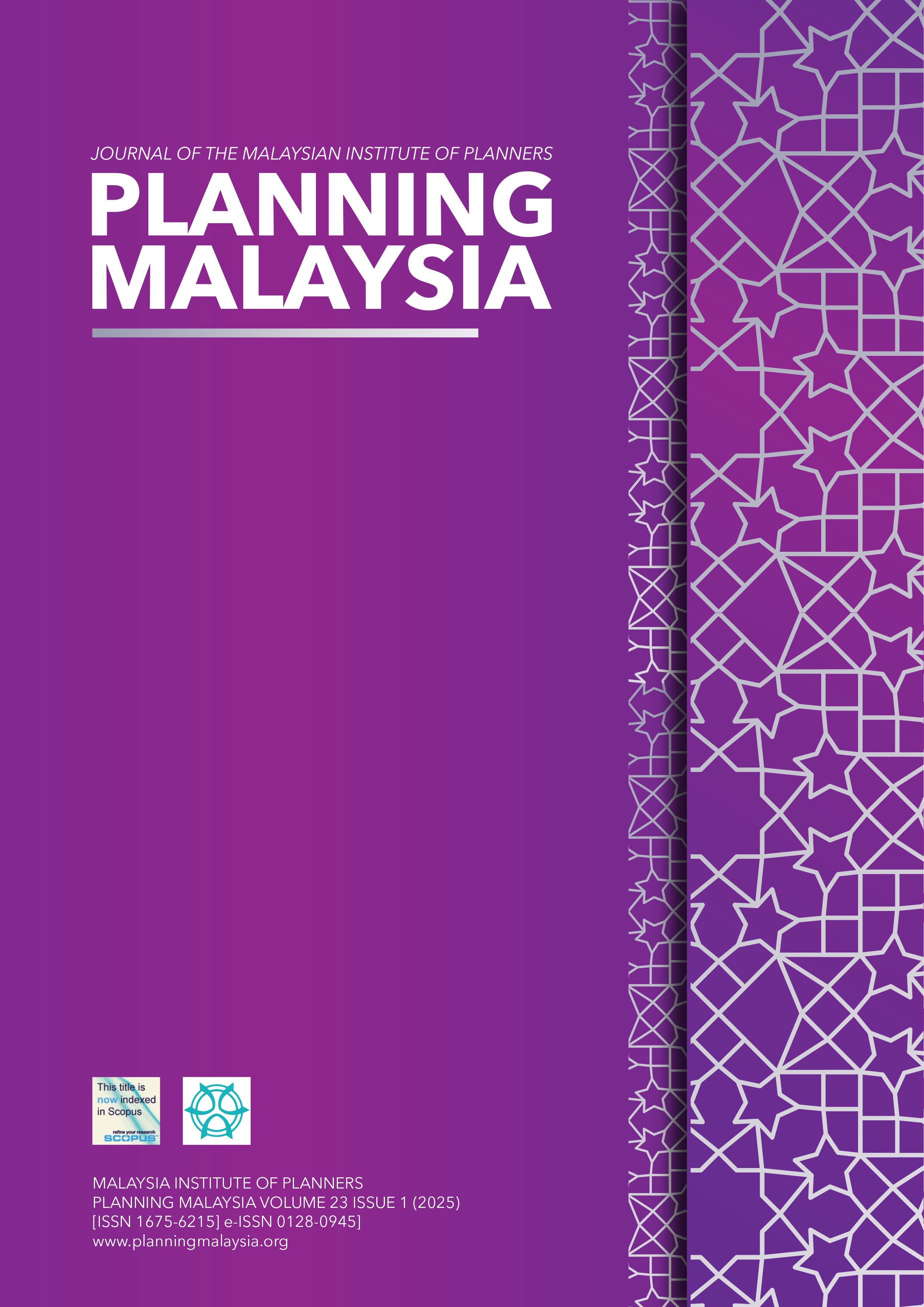THE DELAY OF PLANNING PERMISSION APPLICATION OF TAHFIZ INSTITUTION IN SELANGOR
DOI:
https://doi.org/10.21837/pm.v23i35.1664Keywords:
Urban planning, planning permission, one-stop centre, illegal construction, regulatory processAbstract
This paper investigates the delays in planning permission applications for Tahfiz institutions in Selangor. Malaysia experiences a significant number of illegal constructions that are built without the required planning licences, primarily due to insufficient monitoring and enforcement by local authorities. The absence of supervision results in unapproved constructions that can potentially endanger safety and hinder urban planning initiatives, and this includes the illegal construction of Tahfiz Institutions. There is no proper regulation on the development of Tahfiz Institution in terms of its Planning Permission until the year 2020. In 2021, the Selangor state has established a guideline on the Legalisation of Private Religious Schools (Tahfiz Institution) after the wake of the tragic incident of a deadly fire at Tahfiz Darul Quran Ittifaqiyah in September 2017. A purposive sampling method is chosen for expert interviews. Through interviews with two professional town planners responsible for preparing submissions, two town planning officers from the local authority involved in evaluating planning permissions, and an owner of a Tahfiz institution who has experienced the submission process, as well as a review of secondary data, several key factors were identified: regulatory complexity, a lack of awareness and understanding of technical requirements, inefficiencies in government initiatives, resource constraints, and extended timelines due to technical requirements. The study highlights the significant implications of these findings for the development and operation of Tahfiz institutions. Simplifying regulatory processes, enhancing awareness and educational efforts, improving implemented guidelines, providing financial support, and strengthening coordination among agencies are recommended to address these challenges. Correspondingly, the study acknowledges its limitations, including its focus on the planning permission process. By addressing the identified factors, policymakers can create a more supportive environment for the growth and sustainability of Tahfiz institutions in Malaysia.
Downloads
References
Bruce L. Berg (2004). Qualitative research methods for the social sciences 5. Teaching Sociology 18(4). DOI: 10.2307/1317652 DOI: https://doi.org/10.2307/1317652
Gallent, N., Magalhães, C D., Trigo, S F., Scanlon, K., & Whitehead, C. (2019, October 16). Can ‘permission in principle’ for new housing in England increase certainty, reduce ‘planning risk’, and accelerate housing supply? Routledge, 20(5), 673-688. https://doi.org/10.1080/14649357.2019.1672772 DOI: https://doi.org/10.1080/14649357.2019.1672772
Hassan N.C, Fakhruddin F.M, Ayub A.F, Mutalib L.A, & Jaafar W.M (2015). Tahfiz schools’ entry requirement and characteristics of Tahfiz Students. IJAEDU- International E-Journal of Advances in Education, 1(3). https://www.researchgate.net/publication/288857000_Tahfiz_Schools_Entry_Requirement_And_Characteristics_Of_Tahfiz_Studen Ts DOI: https://doi.org/10.18768/ijaedu.85524
Ifediora, O. (2019). Development control challenges and land use compatibility: Professionals concerns and implications for health and safety, Proceedings of International Conference on A City That Works: Niesv Annual Conference Lagos.https://www.researchgate.net/publication/332371749_Development_control_challenges_and_land_use_compatibility_Professionals_concerns_and_implications_for_health_and_safety
Kamaruddin, S. M., Mohd Rosmi, R., Muhamad Halil, F., Misni, A., & Marzukhi, M. A. (2020). User awareness, impediments and proposed improvements to the one stop centre (Osc) online 3.0 system. Case study: Municipal Council of Subang Jaya, Selangor, Malaysia. Planning Malaysia, 18(14). DOI: https://doi.org/10.21837/pm.v18i14.830
Kementerian Perumahan Kerajaan Tempatan (2019). Manual OSC 3.0 Plus. Proses dan Prosedure Cadangan Pemajuan Serta Pelaksanaan Pusat Setempat (OSC). Edisi Pertama 2019.
Kiger & Varpio (2020). Thematic analysis of qualitative data: AMEE Guide No. 131. Medical Teacher 42(1):1-9. DOI: 10.1080/0142159X.2020.1755030 DOI: https://doi.org/10.1080/0142159X.2020.1755030
Marzukhi, M. A., Omar, D., Arshad, A. F., Ling Hoon Leh, O., Yusup, M., & Jaafar, A. (2019). One stop centre (OSC): Lessons on best practices in planning system delivery. Planning Malaysia, 17(9). DOI: https://doi.org/10.21837/pmjournal.v17.i9.590
Marzukhi, M A., Jaafar, A., & Leh, O L H. (2019, January 1). The effectiveness of building plan approval. Case study: Subang Jaya Municipal Council, Selangor. EDP Sciences, 266, 06005-06005. https://doi.org/10.1051/matecconf/201926606005 DOI: https://doi.org/10.1051/matecconf/201926606005
Merriam, S. (2009). Qualitative research: A guide to design and implementation (2nd ed.). JosseyBass.
Rabe N.S., Sarkawi, A.A. and Osman, M.M (2011). Development control in Sabah within a context of planning system in Malaysia. Conference: APSA Congress 2011, University of Tokyo Hongo Campus, Tokyo, Japan
Tariq, J., & Gardezi, S. S. S. (2023). Study the delays and conflicts for construction projects and their mutual relationship: A review. Ain Shams Engineering Journal/Ain Shams Engineering Journal, 14(1), 101815. https://doi.org/10.1016/j.asej.2022.101815 DOI: https://doi.org/10.1016/j.asej.2022.101815
Tasantab, C. (2016). Building permit as a tool for development control: Evidence from Sekondi-Takoradi. Newcastle-au. https://www.academia.edu/30253313/Building_Permit_as_a_Tool_for_Devel opment_Control_Evidence_from_Sekondi_Takoradi
Tawfek, A. M., & Bera, D. K. (2018). Delay in construction projects: Types, causes and effects.ResearchGate.https://www.researchgate.net/publication/365322620_Delay_in_Construction _Projects_Types_Causes_and_Effects
Toor S.R, Ogunlana O.S. (2008) Problem causing delays in major construction projects in Thailand, Construction Management and Economics 26, 395-408. DOI: https://doi.org/10.1080/01446190801905406
Town and Country Planning Act 1976 (2020). Laws of Malaysia. Kuala Lumpur: Percetakan Nasional Malaysia Berhad.
Downloads
Published
How to Cite
Issue
Section
License

This work is licensed under a Creative Commons Attribution-NonCommercial-NoDerivatives 3.0 Unported License.
Copyright & Creative Commons Licence
eISSN: 0128-0945 © Year. The Authors. Published for Malaysia Institute of Planners. This is an open-access article under the CC BY-NC-ND license.
The authors hold the copyright without restrictions and also retain publishing rights without restrictions.


